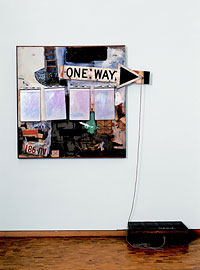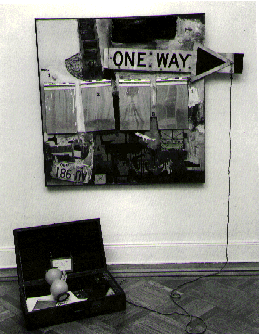 Black Market (Robert Rauschenberg) was originally an interactive work requiring the participation of the viewer. The suitcase contains a card (written in ten languages) inviting viewers to take an object from the case and replace it with one of their own personal objects. The viewer is to draw this object in one of the notepads attached to the surface of the Combine and leave a signature.
Black Market (Robert Rauschenberg) was originally an interactive work requiring the participation of the viewer. The suitcase contains a card (written in ten languages) inviting viewers to take an object from the case and replace it with one of their own personal objects. The viewer is to draw this object in one of the notepads attached to the surface of the Combine and leave a signature.
Of all the pieces I saw at the Rauschenberg exhibit at MOCA last year, I appreciated this one the most. It brings up the always-fun questions of -what is art- and -what is valuable-. Plus, I enjoyed the irony that a piece, which in its original intent brings up these questions, was now guarded. No one was allowed to touch it.  The original art (which was the idea and interactiveness of it, as much as the physical piece itself) was destroyed in a effort to “save” the art. The guard who wouldn’t let you touch the piece, had, instead, her own suitcase where you could take or leave an object (so in this way, I suppose, the idea of the art did live on, although separately). Presumably these objects, since they were not “art” and not connected to the original “art” would be trashed at the end of the exhibition. Fascinating.
The original art (which was the idea and interactiveness of it, as much as the physical piece itself) was destroyed in a effort to “save” the art. The guard who wouldn’t let you touch the piece, had, instead, her own suitcase where you could take or leave an object (so in this way, I suppose, the idea of the art did live on, although separately). Presumably these objects, since they were not “art” and not connected to the original “art” would be trashed at the end of the exhibition. Fascinating.
